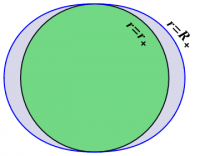- §1. Extending Schwarzschild
- §2. Kruskal Geometry
- §3. Penrose Diagrams
- §4. Charged Black Holes
- §5. Rotating Black Holes
Rotating Black Holes
The Schwarzschild geometry can be regarded as a real slice of a complex geometry, where one can perform a complex rotation and consider the resulting real slice. The resulting line element, known as the (Boyer-Lindquist form of the) Kerr metric, describes a rotating black hole, and is given by \begin{align} ds^2 &= - \frac{\Delta}{\rho^2} \left(dt-a\sin^2\theta\,d\phi\right)^2 + \frac{\sin^2\theta}{\rho^2} \left( (r^2+a^2)\,d\phi-a\,dt \right)^2 \nonumber\\ &\qquad + \frac{\rho^2}{\Delta} dr^2 + \rho^2\,d\theta^2 \end{align} where \begin{align} \rho^2 &= r^2 + a^2 \cos^2\theta \\ \Delta &= r^2 - 2mr + a^2 \end{align} and where $a$ is a constant which can be interpreted as the angular velocity of the black hole.
What are the properties of the Kerr geometry? First of all, it is a solution of Einstein's vacuum equation; this follows from the construction above, and can also be checked directly. 1) When $a=0$, the Kerr line element clearly reduces to the Schwarzschild line element. What symmetries does the Kerr geometry have? It is not spherically symmetric, but merely axisymmetric. There are in fact two Killing vectors, one in the $\phi$ direction, and the other in the $t$ direction. There is also a discrete symmetry, namely reversing both $t$ and $\phi$, a property typical of rotation. 2)
The Kerr geometry has some new and subtle features. First of all, the singularity occurs where $\rho=0$, which turns out to be a ring of radius $a$ in the equatorial plane. There are also regions with $r<0$, and these regions contain closed timelike curves. If $|a|>m>0$, it is even possible to pass through the ring between regions with $r<0$ and $r>0$, avoiding the singularity.
Perhaps even more interesting, there is now a difference between the static limit surfaces, where the $t$ direction changes from timelike to spacelike, which occurs where $g_{tt}=0$, and the horizons, where $g_{rr}\rightarrow\infty$ (more precisely, where $g^{rr}=0$). Static limit surfaces occur where \begin{equation} \Delta-a^2\sin^2\theta = r^2-2mr+a^2\cos^2\theta = 0 \end{equation} that is, where \begin{equation} r = R_\pm = m \pm \sqrt{m^2-a^2\cos^2\theta} \end{equation} whereas horizons occur where \begin{equation} \Delta = r^2 - 2mr + a^2 = 0 \end{equation} that is, where \begin{equation} r = r_\pm = m \pm \sqrt{m^2-a^2} \end{equation} As shown in Figure 1, there is therefore a region between the horizon at $r=r_+$ and the static limit surface at $r=R_+$, called the ergosphere, which is physically accessible (outside the horizon), but with the $t$ direction spacelike. Inside the ergosphere, energy has “the wrong sign”. This fact makes it possible to mine energy from a Kerr black hole by jettisoning objects from ships traveling in the ergosphere region, as originally proposed by Penrose.
Further discussion can be found in Chapter 19 of d'Inverno. The above construction involving a complex rotation can also be applied to the Reissner-Nordström geometry, thus generalizing the Kerr geometry so as to include charge. The resulting geometry, known as the Kerr-Newman geometry, has been shown to be the most general black hole solution possible; a black hole is completely characterized by its mass, charge, and angular velocity. In John Wheeler's famous words, “A black hole has no hair.”
